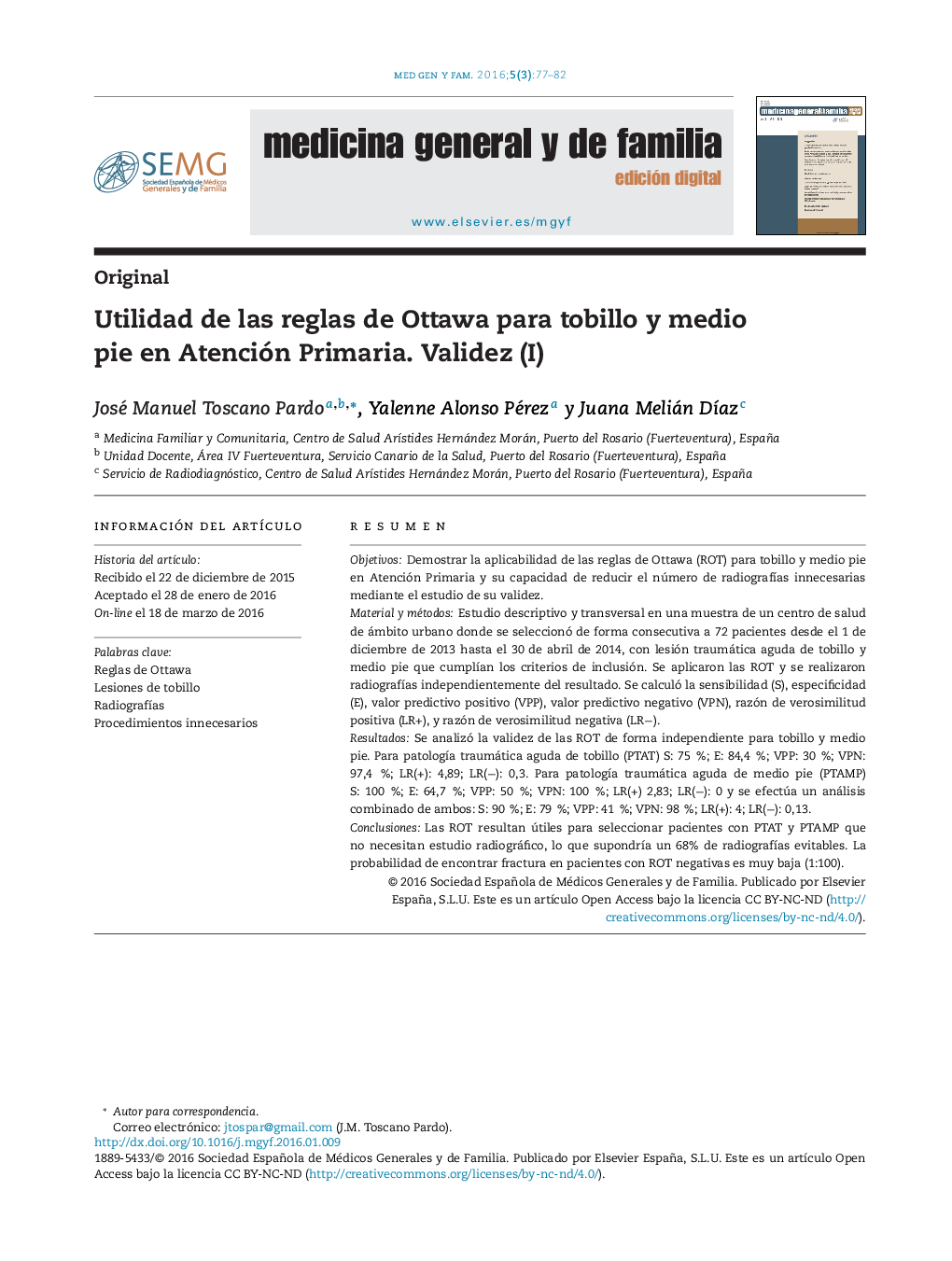| کد مقاله | کد نشریه | سال انتشار | مقاله انگلیسی | نسخه تمام متن |
|---|---|---|---|---|
| 3804522 | 1597460 | 2016 | 6 صفحه PDF | دانلود رایگان |

ResumenObjetivosDemostrar la aplicabilidad de las reglas de Ottawa (ROT) para tobillo y medio pie en Atención Primaria y su capacidad de reducir el número de radiografías innecesarias mediante el estudio de su validez.Material y métodosEstudio descriptivo y transversal en una muestra de un centro de salud de ámbito urbano donde se seleccionó de forma consecutiva a 72 pacientes desde el 1 de diciembre de 2013 hasta el 30 de abril de 2014, con lesión traumática aguda de tobillo y medio pie que cumplían los criterios de inclusión. Se aplicaron las ROT y se realizaron radiografías independientemente del resultado. Se calculó la sensibilidad (S), especificidad (E), valor predictivo positivo (VPP), valor predictivo negativo (VPN), razón de verosimilitud positiva (LR+), y razón de verosimilitud negativa (LR−).ResultadosSe analizó la validez de las ROT de forma independiente para tobillo y medio pie. Para patología traumática aguda de tobillo (PTAT) S: 75 %; E: 84,4 %; VPP: 30 %; VPN: 97,4 %; LR(+): 4,89; LR(−): 0,3. Para patología traumática aguda de medio pie (PTAMP) S: 100 %; E: 64,7 %; VPP: 50 %; VPN: 100 %; LR(+) 2,83; LR(−): 0 y se efectúa un análisis combinado de ambos: S: 90 %; E: 79 %; VPP: 41 %; VPN: 98 %; LR(+): 4; LR(−): 0,13.ConclusionesLas ROT resultan útiles para seleccionar pacientes con PTAT y PTAMP que no necesitan estudio radiográfico, lo que supondría un 68% de radiografías evitables. La probabilidad de encontrar fractura en pacientes con ROT negativas es muy baja (1:100).
ObjectiveTo demonstrate the applicability of the Ottawa rules (OR) for ankle and mid foot in Primary Care and its ability in reducing the number of unnecessary radiographs, by designing a validity study.Material and methodsA descriptive and cross-sectional study was conducted on a sample of 72 patients with ankle and middle foot traumas who met the inclusion criteria and enrolled consecutively in a Primary Care setting from 1 December 2013 to 30 April 2014. The OR was applied and radiographs taken on all patients regardless of the outcomes. Calculation of sensitivity (S), specificity (E), positive and negative predictive value (PPV and NPV), positive and negative likelihood ratios (LR+ and LR−).ResultsThe validity of the OR was analysed separately for ankle and midfoot. Acute ankle trauma (AAT): S: 75 %, E: 84.4 %, PPV: 30 %, NPV: 97.4 %, LR(+): 4.89 and LR(−) 0.3. Acute midfoot trauma (AMFT): S: 100 %, E: 64.7 %, PPV: 50 %, NPV: 100 %, LR(+): 2.83, LR(−): 0. A pooled analysis resulted in: S: 90 %, E: 79 %, PPV: 41 %, NPV: 98 %, LR(+): 4 and LR(−): 0.13.ConclusionsOR are valid and useful in Primary Care to select patients with AAT and AMFT who do not need radiographs, which would reduce the total amount of them by 68%. The probability of having a fracture with a negative test is very low (1 in 100).
Journal: Medicina General y de Familia - Volume 5, Issue 3, July–September 2016, Pages 77–82